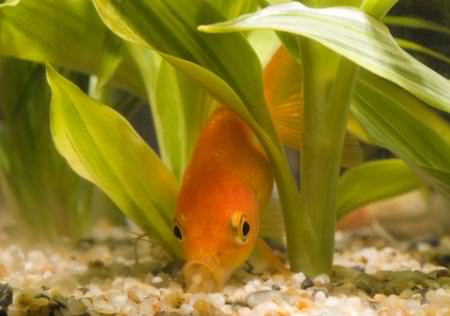| Back to Back Issues Page |
 |
|
The Goldfish Gazette, Issue #030 -- Setting Up a Goldfish Aquarium June 30, 2016 |
Goldfish Care Tips and GuidelinesA Free Monthly Resource For Goldfish Enthusiasts In This Issue
Setting up a Goldfish aquarium just the way you like it is a big part of the fun of keeping Goldfish. However, how you set up the aquarium can cause serious injury or even death to our beloved pets as happened to me recently. Setting Up a Goldfish Aquarium
I was graphically reminded recently how easy it is to lose a fish from a simple error. I lost a juvenile Black Moor because a pebble lodged in its mouth so tightly it restricted water flow through the mouth and gills. What had happened was the fish had grown bigger over several months, and a pebble became small enough for the fish to pick up in its mouth, but it was unable to spit it out. So in this issue I am concentrating on the inhabitants of your aquarium and how your setup can have a major impact on their health. Other important issues such as where to site your aquarium and on what are covered in my website page Goldfish Aquarium Setup Basics. Given my recent experience, the appropriate place to start is with the substrate or gravel. GravelGoldfish are primarily bottom feeders because that is where their food source is. They browse by sucking up sediment looking for worms, invertebrates and insect larvae. Gravel size should either be small enough for your fish to suck up and spit out, or too large for it to fit into their mouths.The size of gravel you choose depends on variety and size of fish. Very large gravel can make it difficult for varieties with protruding eyes such as Moors and Celestials to find food in the gravel compared to say a Comet. Larger gravel also makes it easier for food to fall into crevices which can't be reached by the fish. Choose a gravel size that is either half the size of your fish’s mouth, or twice as large, keeping in mind that your fish will grow. If you plan on growing plants that develop roots, smaller gravels are easier to plant in, but larger gravel sizes allow more water circulation, reducing the build-up of wastes. I prefer using natural gravel but colored synthetic gravels are now available. Don't use sand as a substrate as it tends to compact, is hard to clean and makes the water alkaline. PlantsPlants are again a matter of personal choice.Keep in mind that Goldfish will dig around in the gravel so plants need to be well weighted down with lead strips (not plumber’s roofing lead as it is poisonous) giving them a chance to become established. Refer to my page on suitable plants to use in a Goldfish aquarium before buying anything expensive and finding it shredded by the next morning. Artificial plants are a good option for Goldfish but check they don’t come with any sharp plastic protrusions. Planting density is an important consideration for fancy varieties. With protruding eyes, twin caudal fins, and bulbous bodies, swimming in densely planted aquariums is a problem. The fancier the variety, the less densely planted the aquarium should be to avoid fish getting trapped and fins or water sacs being damaged. DecorationsA lot of aquarium decorations sold in pet shops are designed for sales potential in mind, not the safety of fish.Decorations should have no sharp edges whatsoever. Their design shouldn’t allow food to become unreachable or fish to get trapped inside. For fancy varieties without normal eyes, don’t clutter the aquarium as it makes finding food that much harder. FiltersThere are many YouTube videos on the Internet that show aquariums owned by Goldfish experts who are explaining some aspect of goldfish care.The only problem is their fish can be seen swimming frantically against the water current generated by the filter, with twin tailed varieties often bouncing around like corks. This is happening 24 hours a day to the fish. While a high water flow through a filter is required for Goldfish, it shouldn’t be so strong that the fish can’t rest somewhere in the aquarium. Another danger for fancy varieties is the intake tube. If the suction is too strong, fins and water sacs can be damaged when sucked against sharp edges or up the tube itself. Bare Aquariums Used by ExpertsMany Goldfish keepers and breeders raise their fish in bare aquariums. The reasons are obvious:Cleanliness – To maximize growth rates, heavy feeding is required. A bare aquarium ensures all food put into the aquarium is likely to be eaten, no matter how poor the eyesight of the fish. It also makes keeping the aquarium spotless easier. Safety – Anyone who enters fish into shows knows that damaged scales and fins mean lost points. Also, champion fish are worth a lot of money and are hard to replace. A bare aquarium reduces the risk of accidents. Breeding – Because Goldfish scatter their eggs during breeding, an aquarium full of gravel, plants and decorations makes it impossible to flush the eggs or keep the environment clean. The aquarium will still have to be stripped at some time when the fry have to be caught for culling or transfer. To read more about aquarium setups click here... Comments? Ideas? Feedback? I'd love to hear from you. Just reply to this e-zine and tell me what you think, or what topics you want covered. Next Month's Topic Showing Goldfishwww.facebook.com/aboutgoldfish |
| Back to Back Issues Page |